HART and Foundation Fieldbus Technologies

HART
Devices using HART communication technology hit the market in the early 1980’s and there are around 10 million HART devices in service throughout the world today. HART is well proven, has a large Installed base and the technology is simple and well understood by technicians/engineers.
HART Field Communications Protocol is superimposed on the 4-20mA signal and provides two way communications with smart field instruments without compromising the integrity of the measured data. HART communicates at 1200 bps and provides a host with two or more digital updates per second from a field device. Generally a single pair cable is installed for each device and the 4-20 mA signal is generally used for the Process Variable, however this parameter is also available via device digital data. Also several devices can connect in series in the same current loop, providing digital data from each device. Current in the loop stays at a constant value and in this case the PV for each device is available from the digital data. Multi-drop HART networks are used in applications where fast update rates are not required. This feature is rarely used.
HART is Master/Slave by design thus there can only be only two Masters eg., Control System/Hand Held.
Foundation Fieldbus
Devices using Foundation Fieldbus Technology became available in 1998 and there are over 700,000 Foundation Fieldbus Devices installed in over 10,000 systems. The technology is now proven and has a growing installed base
Foundation Fieldbus is a true Multidrop System and has numerous advantages including:
- Wiring savings
- Hardware savings-fewer devices (instruments barriers and I/O)
- Documentation savings-Simpler layout and drawings
- Reduced Engineering costs
- Footprint savings
- Multi-variable field devices
- Interoperability and freedom of choice
- Reduced Commissioning and startup costs
- Reduced downtime
- Integrity improved
- DCS future capacity savings
- Control in the field
- Device Plug and Play
- On line configuration
- Time Stamping and Synchronisation
- Obsolescence Robustness
- Status Information
- Tag Search Capability
- Interface to High Speed Ethernet
Trend storage in the field device
- Predictive Maintenance
- DCS future capacity savings
- Automated data collection for asset management
The “Hype”
Don’t believe all the “hype” given out by manufacturers, especially those that tell you that you can get everything provided by Foundation Fieldbus with HART.
The Facts – Differences, Advantages and Disadvantages
Power
Foundation Fieldbus has a distinct advantage when considering power availability, HART has a Power Limitation in that it has only around 35 milliwatts and 4mA available for the HART signal. FF has a minimum power requirement of 8mA with no specification limit, thus the ultimate FF limit is the H1 segment power budget. Foundation Fieldbus shares a common physical layer which provides bus power and communication for up to 32 devices over a single pair of wire. Up to 2 amps at 12 to 32 volts can be provided over this wire pair, but non- incendive installations generally limit the power to a half amp or less, and intrinsically safe installations limit current and voltage to lower levels. As a result FF devices have an order of magnitude more power available, even for Intrinsically Safe applications. In regard to advances in silicon power consumption ie., processor power, these will be the same for HART or FF thus FF will always have capability for more functionality.
Communication Performance
The slow HART baud rate of 1200 bits per second puts an additional burden on the control system, in that it takes a long time to ask 1000 or 2000 instruments how they “feel”. FF H1 communicates at 31,250 bits/sec thus communication performance is demonstrably better than HART
Transmitter Diagnostics
HART technology has the ability to provide diagnostics for the device only, this includes any predictive options. Thus HART has no knowledge of other devices. FF however communicates with other devices, opening a whole new potential in regards to advanced diagnostics such as plant health systems. Many basic device diagnostics are a result of HART legacy. For both HART and FF you will hear all about the “wonderful” transmitter diagnostics which can tell you every little thing about the status of the transmitter. Whilst this is useful for commissioning activities, generally transmitters are so reliable these days that the information is rarely accessed and used.
These diagnostics are really a throwback to the days when transmitters were unreliable and the information was thus extremely useful. As a result we have a huge diagnostic database of what is pretty useless information. Manufacturers found it easy to just “macro” across the existing HART diagnostics to FF and thus it is the installed HART base which is holding back the potential of FF, as diagnostics in the field devices are rather primitive compared to what is possible. HART technology is so limited on power and communication capability that advanced diagnostics have not been possible and even simple memory checks have been run as a very slow background task (every 20 minutes).
Today, Foundation Fieldbus provides more power and communication, but most vendors have a strong economic incentive to leverage their device development across multiple platforms. The least common denominator has won out in many implementations and diagnostics for many vendors is the same in all busses. The Foundation Fieldbus capability to support diagnostics has been largely unexploited. Only in the last couple of years have manufacturers started a real program to accelerate diagnostics development in FF devices.
Some other vendors are concentrating most of their diagnostics development in application host computers that run on top of an OPC server for field data. Most of these applications are designed to run at very low rates with slow data update. The data update is typically at historian update frequency, and the applications may run on a schedule from every few hours to every few days. Some run only on demand.
Pushing these diagnostics down into field devices can provide much improved diagnostic capability in that the diagnostics can run continuously with a high data update rate (20 to 100 Hz). This high rate can measure problems that will not be observable with the app node technology. This high data rate processing in field devices is the focus of current Research and Development, and is the basis for use of Foundation Fieldbus for advanced diagnostics. App node diagnostic technology is likely to be developed further and will serve the legacy HART installed base market.
Advanced Diagnostics
Whilst you will get some vendors telling you that some HART devices provide advanced diagnostics, these will be much more limited than those available through FF. HART does not have the processing power to provide the capability to mirror FF and also is of course constrained in that any diagnostics can only be associated with the specific device. The fact that FF gives the ability to communicate across devices enables more complex applications such as Statistical Process Monitoring and Machinery Health monitoring. These diagnostics use complex maths and thus a HART based device does not have the electrical power necessary to do the number crunching required.
The Future capabilities of FF advanced diagnostics are huge with potential for self validating transmitters, valves, relief valves etc. If a legacy system is installed these features will not be available.
Push versus Poll
HART transmitters are polled for HART status periodically whereas Foundation Fieldbus devices push. Thus HART transmitters can potentially miss field intermittent problems. A typical example of this is where a company had moisture in transmitters causing intermittent problems. In the HART system the status bit set and then cleared. Polling missed the bit as it was being set and cleared and thus the problem was not detected. With FF, devices push with events latched and time stamped in the device. The event is then sent to the host. There is no chance of missing field problems with FF.
Multidrop Capability
HART provides a single pair of wire to each field device and powers the device over the 4 to 20 ma signal current.
HART has a very limited digital only capability and a theoretical limit of 15 devices, however it is practically only about 3 because of the slow SERIES loop.
FF is a true multidrop technology with a theoretical limit 32 devices which is practically 12-16. Furthermore FISCO, FNICO and High Power Trunk concepts have radically changed the number of instruments that can be installed in Ex environments.
Use in Safety Instrumented Systems
Presently HART is the only option and all devices are wired individually. This is one of the key decision makers in brownfield plants staying with HART ie., the same technology across the plant.
The Fieldbus Foundation is working on FF safety systems, however it needs a very robust approach. The lack of FF SIS is holding back full acceptance of the technology. The FF specification is now in place and first devices are likely in 2008-09.
Control in the Field and Advanced applications
Foundation Fieldbus supports PID Control in the field. This control is very fast and synchronous compared to traditional non-synchronous DCS control. It also has less failure modes. FF Devices form a reliable network of microprocessors capable of restoring the “holy grail” of process control, namely single-loop integrity. FF is the only fieldbus technology capable of supporting the deployment of control strategies into field-devices using standard and advanced function blocks (e.g., analog input, analog output, PID control; and arithmetic, integrator, splitter, timer). The result of this is that it;
– reduces complexity and costs -improves reliability and scalability – increases flexibility and availability
HART cannot provide this option.
Multivariables
HART does actually have this feature, however it is available in digital mode only and not well accepted by industry. Some manufacturers use an interposing “Multiplexer” device at the host that polls the single device for additional parameters and then converts this information to analogue readings that can be used for other purposes in the control system.
FF however has instruments already available such as multiple temperature interfaces, pressure and temperature plus flow. This feature has huge potential, for example how about one transmitter which gives you level, temperature, pressure, sg. Whilst not available to date only FF has the processing power to make it possible.
Plug and Play
HART has a very limited ability to look at one transmitter only whereas FF if configured correctly means that once you plug in an instrument you can access all its details and get playing! This is a very useful feature especially during installation/ commissioning.
Footprint and Hardware Savings
If you require full functionality HART adds to hardware, multiplexers are required to source information from several devices and this generally creates a more complex interface. Many host systems today can incorporate HART signals directly to their I/O so do not require a parallel stripping system , this has disadvantage however in that it will add extra load to the host.
FF has a huge advantage in that it renders obsolete all separate signal conditioners, isolation amplifiers, input cards, output cards, CPU cards, I/P converters, interconnecting wires etc.
Commissioning Speed
Conflicting views in regards to commissioning time are reported on a regular and occasionally a statement is made that “commissioning a FF device takes longer than a 4-20mA HART device”. This occurs if the FF project engineering is not done methodically as detailed in AG181 Foundation Fieldbus System Engineering Guide and associated training has been completed ensuring FF competency. Any training must cover all disciplines, process and technical personnel. Otherwise you will find Instrument Technicians who utilise analogue techniques and tools. Then a FF installation will be difficult and take longer than an analogue one. Generally commissioning times are approximately as follows;
HART – Up to 4 hours for individually wired devices and physical intervention is required to source signal via handheld, which is a disadvantage.
FF – The networking capability of FF allows the user to commission an FF field device in minutes, this has been proven in many installations. Time studies have documented savings of FF being 6 times faster than HART.
Full Specifications- In the Device
In some FF devices the full specifications are embedded at the factory and thus these travel with the instrument and give the advantages that they can be uploaded directly to Asset Management software. This reduces commissioning time and the time required to perform diagnostics. This feature is not available with HART.
Performance Diagnostics Inside a Digital Valve Controller Provide 24/7 Coverage
The power of FF is demonstrated by the availability on a 24/7 basis of DVC performance diagnostics. Whilst some data is available with HART only FF has the ability to provide this kind of enhanced feature.
Future Proof Devices – Typical Upgrade Capability in the Field
With Third Party devices conformant with the Fieldbus Specification FF there is the ability to download a new version of firmware over the H1 link. There is no need to disconnect the device from the H1 segment. This feature is not available with HART where any upgrade would require a new device or electronic puck.
Downloads
All of this new development is fine except for one problem – installed base. Foundation Fieldbus provides a way out. Foundation Fieldbus allows field devices to have software upgrades downloaded over the bus. So, as new capability comes along in field devices, the new capability can be added to the existing installed base.
HART technology does not allow downloads. The problem is back to power budget. HART devices have to use ASIC chips for processors to conserve power. The program for these processors is contained in a mask that is used to make the chips as a result upgrading the program in a HART device requires changing out the entire device.
FF devices can afford to have general- purpose processors and a downloadable stored program. A software download is a relative simple procedure if Foundation specifications are implemented.
Downside to FF
Foundation Fieldbus is the most complex technology in use in process control today. It has not been easy for device vendors to make the transition from HART to FF. The extra complexity has led to an increase in field device software bugs of various types. These bugs are manageable (fixable), but have taken time and cost money to manage.
The lagging development of advanced diagnostics and extra cost and complexity of FF has hurt the expected benefits of the technology. In many cases, the current installation of FF has only provided the platform for future benefits when further diagnostic development is done.
Training required- In the future new product investment is going to occur more and more in FF products because they can do more.
Why do some Manufacturers / Suppliers continue to push HART and put up a “Smokescreen”?
Unfortunately some manufacturers / suppliers are loath to really push the benefits of FF over HART because of the risk to the established HART market which is still a profitable part of their business. As a result they sometimes continue to add as much of the FF diagnostics as possible to HART Transmitters without developing the higher level to its full potential. In some cases the FF device has more functionality but this is not particularly highlighted in the literature. No diagnostic or HART v FF comparisons are available from published data on websites in most cases. As a result some manufacturers may be holding back the development of FF because of the perceived business risk. Also companies that have not developed FF for their devices and thus have only HART functionality may potentially spread misinformation that EVERYTHING is available via HART. As a result they may get business and hence the reason that other manufacturers have to counter this by having their own HART alternate.
End Users need to push for full visibility of all features so that an educated decision on using HART or fieldbus can be determined. At the moment the “smokescreen” precludes this.
Brownfield and Greenfield Plants- What technology should be used?
BROWNFIELD
It is likely that HART will be supported for the foreseeable future because of the huge installed base and is likely to be utilised as follows;
- Small upgrades –HART is the logical migration path for the millions of legacy systems still in use and no loss of investment occurs when upgrading using the HART path.
- SIS – upgrades or new installation – HART the only solution at this time
- Major instrument upgrade – Projects such as these should be subject to a business case and the following questions should be addressed;
- Is the wiring being changed out completely or partially?
- Is there room in the equipment room for new equipment?
- What is the projected life of the ongoing installation?
- Will advanced diagnostics be required in the future?
- Do I wish to “Future Proof” my instrumentation?
- What is my commissioning timeframe?
- My Plant is pneumatic which route should I take?
- What would be the training and competency cost of going FF?
Any decision should then be based on the economics.
GREENFIELD
FF has been proven to be more economic for Greenfield applications when appropriate emphasis has been put on training and competencies of operators, technicians, and engineers across the whole lifecycle ie., Design/Fabrication/FAT/Installation/Commissioning and Maintenance.
Based on the advantages of FF previously outlined in this article THE USE OF HART SYSTEMS ON NEW PLANTS DOES NOT HAVE ANY VISION FOR THE FUTURE
Conclusion
HART and FF will continue to be “required technologies” for the foreseeable future however FF has considerable advantages over HART and the technology “gap” will grow over time. Eventually HART growth will decline and its installed base drop as the benefits of FF technology are accepted.
Simple HART v FF Comparison Chart
View/Download the Below Picture
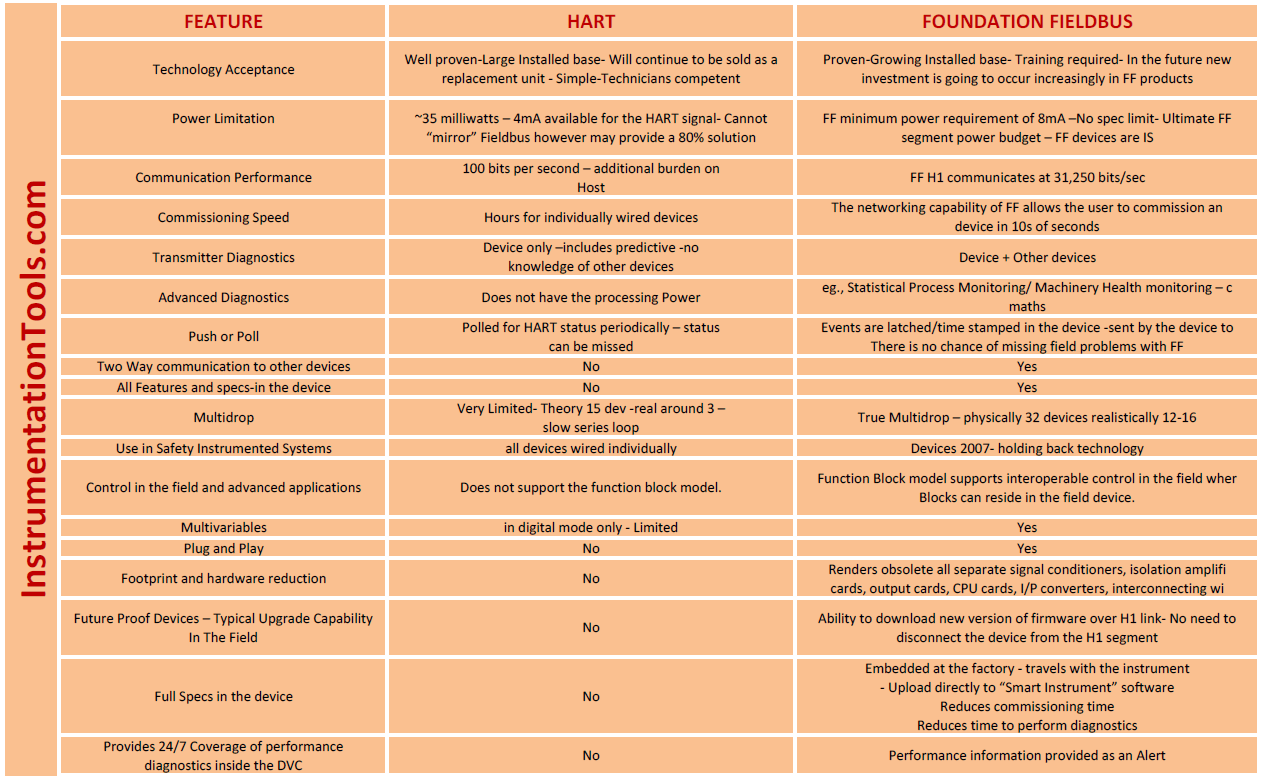
Also Read: Fieldbus Interview Questions & Answers


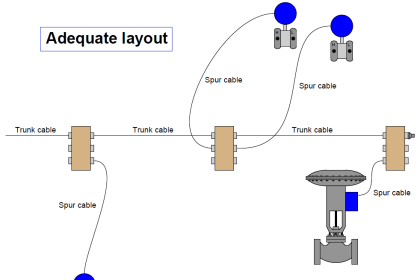
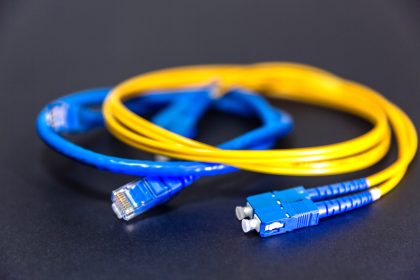
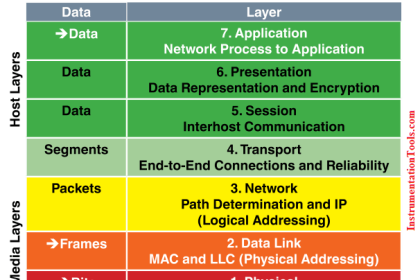
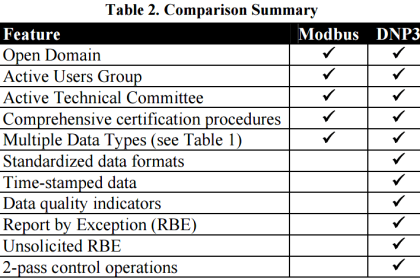
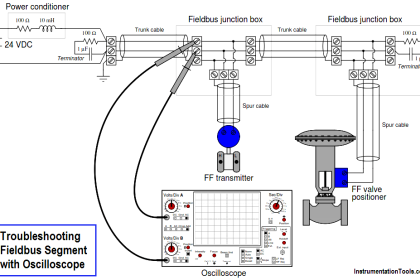
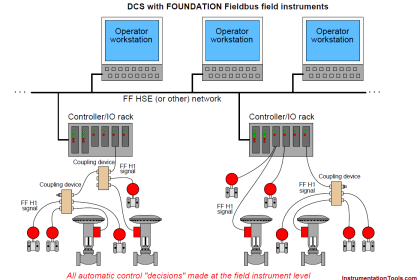
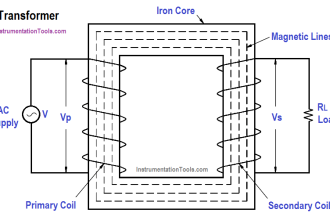
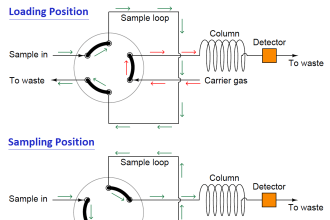


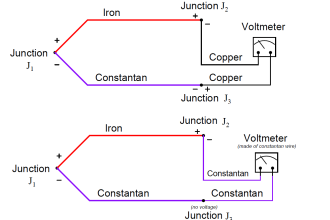
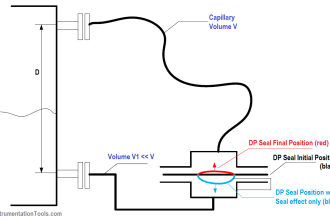



FF is bad, I have a bad experience with it…. Hart is better.
Can i use hart communicator to check transmitter temperature FF.?